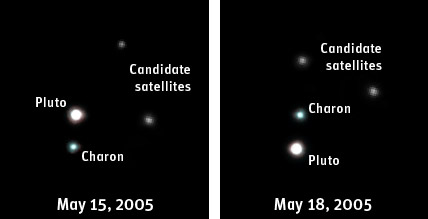
Pluto's newest moons were spotted by the Hubble Space Telescope in mid-May using the Advanced Camera for Surveys.
Courtesy NASA, ESA, H. Weaver (JHU/APL), A. Stern (SwRI), and the HST Pluto Companion Search Team.
Astronomers using the Hubble Space Telescope (HST) have found two new moons orbiting Pluto. The discovery gives the ninth planet three satellites in total and makes it the first quadruple Kuiper Belt system.
S. Alan Stern (Southwest Research Institute, Colorado) and Harold F. Weaver (Johns Hopkins University Applied Physics Laboratory) observed the distant body on May 15th and 18th for the upcoming New Horizons mission, which will launch toward Pluto in January. Provisionally designated S/2005 P1 and S/2005 P2, the pair are 64,500 and 49,500 kilometers (40,000 and 30,700 miles) away from Pluto, respectively, and appear to orbit in the same plane as Charon. They are 23.1 and 23.4 magnitude, making them about 150 km and 100 km wide (assuming a reflectivity similar to ordinary meteorites), with periods of 38 and 25.5 days.
More interesting, however, is how the moons formed in the first place. According to Stern, they aren't captured bodies — they likely formed in the same high-energy collision that created Pluto's largest moon, Charon.
Robin M. Canup (Southwest Research Institute, Colorado) agrees. She has published several findings about the formation of the Pluto-Charon system and will be quickly applying that research toward understanding how these moons formed. "My gut," says Canup," is that these objects are connected to
a Charon-formation collision."
The moons' confirmation came in late October when Marc W. Buie (Lowell Observatory) identified the satellites in HST images of Pluto shot in 2002. Buie had not seen them earlier because he had used short exposures of Pluto rather that the eight-minute-long images Stern and Weaver took.
Stern and his team tried to observe the moons from Earth multiple times since the May observations, but each attempt was met with failure. Either sky conditions were poor or the planet was too low on the horizon for the moons to be visible. Because Pluto is currently behind the Sun, the next opportunity astronomers will have to see the satellites from Earth won't be until February.
But even with more ground observations, Pluto is unlikely to reveal any more large moons. Weaver and Stern say their Hubble observations probed deep and thoroughly enough to rule out other Pluto satellites larger than 20 kilometers across. That said, Stern adds, "there could still be some pip-squeaks" awaiting New Horizons' arrival in 2015.
 0
0
Comments
You must be logged in to post a comment.